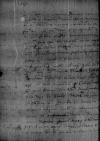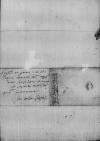Scripsi proximis litteris moram ipsam et quidquid incommodi nobis in Hispanico litore acciderat, par est, ut Tuae Excellantiae navigationis nostrae infelicis quoque certiorem reddam. Cum enim ex Spain (Hispania)⌊HispaniaSpain (Hispania)⌋ solvissemus, postridie eius diei maximam maris tempestatem perpessi, ut iam de salute desperaremus, tanta enim erat undarum et procellarum vis, quae undique navim implerant, ut nil aliud consilii quam in exhaurienda sentina nobis superinscribed⌈nobisnobis superinscribed⌉ reliqui esset. Alii suarum mercium, ego vero mulae meae maioris, quam in patriam ducere statueram, eicere coacti, tredecima tandem die England⌊AngliamEngland⌋ attigimus[2], quam relicta classe ingressus sum, contulique me per equos dispositos London (Londinium), city in England, on the Thames river⌊LondinumLondon (Londinium), city in England, on the Thames river⌋, ubi opera et litteris domini oratoris England⌊AngliaeEngland⌋, domini Edward Lee (*ca. 1482 – †1544), 1525-1530 envoy of Henry VIII to emperor Charles V and to pope Clement VII, 1531-1544 archbishop of York⌊LeiEdward Lee (*ca. 1482 – †1544), 1525-1530 envoy of Henry VIII to emperor Charles V and to pope Clement VII, 1531-1544 archbishop of York⌋ hospitio honestissime susceptus et tractatus fui lautissime. Deinde me ad Henry VIII Tudor (*1491 – †1547), 1509-1547 King of England; son of Henry VII Tudor and Elizabeth of York⌊regemHenry VIII Tudor (*1491 – †1547), 1509-1547 King of England; son of Henry VII Tudor and Elizabeth of York⌋ contuli, cum quo (uti omnium principum est humanissimus) ad mediam horam egi donatusque fui a maiestate sua annulis aureis et argenteis,
 BCz, 1595, p. 10
vino praeterea ac dapibus de auratis vasis et lancibus in diversorium allatis, ita, ut mirarer tantam maiestatis suae erga me clementiam et munificentiam, hoc ipsum vero contigit opera domini Edward Lee (*ca. 1482 – †1544), 1525-1530 envoy of Henry VIII to emperor Charles V and to pope Clement VII, 1531-1544 archbishop of York⌊LeiEdward Lee (*ca. 1482 – †1544), 1525-1530 envoy of Henry VIII to emperor Charles V and to pope Clement VII, 1531-1544 archbishop of York⌋ et domini doctoris Richard Sampson (†1554), 1522-1525 ambassador of Henry VIII to emperor Charles V⌊SampsonRichard Sampson (†1554), 1522-1525 ambassador of Henry VIII to emperor Charles V⌋, prioris oratoris apud Charles V of Habsburg (*1500 – †1558), ruler of the Burgundian territories (1506-1555), King of Spain as Charles I (1516-1556), King of Naples and Sicily, King of the Romans (1519-1530), Holy Roman Emperor of the German Nation (elected 1519, crowned 1530, abdicated 1556); son of Philip I the Handsome and Joanna the Mad of Castile⌊caesaremCharles V of Habsburg (*1500 – †1558), ruler of the Burgundian territories (1506-1555), King of Spain as Charles I (1516-1556), King of Naples and Sicily, King of the Romans (1519-1530), Holy Roman Emperor of the German Nation (elected 1519, crowned 1530, abdicated 1556); son of Philip I the Handsome and Joanna the Mad of Castile⌋, cuius opera hic usus sum, qui in me, ut suum erga caesarem animum) monstrare voluerunt. Obtinui itaque litteras passus ex sententia crasque hinc discedam in Flanders (Flandria), county in the Low Countries, part of the Habsburg Netherlands from 1482, today corresponding to the Belgian provinces of Western Flanders and Eastern Flanders, the region of Zeeuws-Vlaanderen in the Netherlands and part of the Département du Nord in France⌊FlandriamFlanders (Flandria), county in the Low Countries, part of the Habsburg Netherlands from 1482, today corresponding to the Belgian provinces of Western Flanders and Eastern Flanders, the region of Zeeuws-Vlaanderen in the Netherlands and part of the Département du Nord in France⌋.
BCz, 1595, p. 10
vino praeterea ac dapibus de auratis vasis et lancibus in diversorium allatis, ita, ut mirarer tantam maiestatis suae erga me clementiam et munificentiam, hoc ipsum vero contigit opera domini Edward Lee (*ca. 1482 – †1544), 1525-1530 envoy of Henry VIII to emperor Charles V and to pope Clement VII, 1531-1544 archbishop of York⌊LeiEdward Lee (*ca. 1482 – †1544), 1525-1530 envoy of Henry VIII to emperor Charles V and to pope Clement VII, 1531-1544 archbishop of York⌋ et domini doctoris Richard Sampson (†1554), 1522-1525 ambassador of Henry VIII to emperor Charles V⌊SampsonRichard Sampson (†1554), 1522-1525 ambassador of Henry VIII to emperor Charles V⌋, prioris oratoris apud Charles V of Habsburg (*1500 – †1558), ruler of the Burgundian territories (1506-1555), King of Spain as Charles I (1516-1556), King of Naples and Sicily, King of the Romans (1519-1530), Holy Roman Emperor of the German Nation (elected 1519, crowned 1530, abdicated 1556); son of Philip I the Handsome and Joanna the Mad of Castile⌊caesaremCharles V of Habsburg (*1500 – †1558), ruler of the Burgundian territories (1506-1555), King of Spain as Charles I (1516-1556), King of Naples and Sicily, King of the Romans (1519-1530), Holy Roman Emperor of the German Nation (elected 1519, crowned 1530, abdicated 1556); son of Philip I the Handsome and Joanna the Mad of Castile⌋, cuius opera hic usus sum, qui in me, ut suum erga caesarem animum) monstrare voluerunt. Obtinui itaque litteras passus ex sententia crasque hinc discedam in Flanders (Flandria), county in the Low Countries, part of the Habsburg Netherlands from 1482, today corresponding to the Belgian provinces of Western Flanders and Eastern Flanders, the region of Zeeuws-Vlaanderen in the Netherlands and part of the Département du Nord in France⌊FlandriamFlanders (Flandria), county in the Low Countries, part of the Habsburg Netherlands from 1482, today corresponding to the Belgian provinces of Western Flanders and Eastern Flanders, the region of Zeeuws-Vlaanderen in the Netherlands and part of the Département du Nord in France⌋.
Serenissimus Henry VIII Tudor (*1491 – †1547), 1509-1547 King of England; son of Henry VII Tudor and Elizabeth of York⌊Angliae rexHenry VIII Tudor (*1491 – †1547), 1509-1547 King of England; son of Henry VII Tudor and Elizabeth of York⌋ mitit ad Francis I of Valois (*1494 – †1547), 1515-1547 King of France; son of Charles, Count of Angoulême, and Louise of Savoy⌊regem GalliaeFrancis I of Valois (*1494 – †1547), 1515-1547 King of France; son of Charles, Count of Angoulême, and Louise of Savoy⌋ Thomas Wolsey (*ca. 1471 – †1530), 1514-1530 Archbishop of York; 1515-1529 Lord Chancellor of England; 1515 elevated to cardinal⌊car(dina)lemThomas Wolsey (*ca. 1471 – †1530), 1514-1530 Archbishop of York; 1515-1529 Lord Chancellor of England; 1515 elevated to cardinal⌋, qui heri hinc magna commitiva splendide hidden by binding⌈[e]e hidden by binding⌉ London (Londinium), city in England, on the Thames river⌊LondinumLondon (Londinium), city in England, on the Thames river⌋ egressus, rumor erat ipsum mo[...] hidden by binding⌈[...][...] hidden by binding⌉ regem cum Francis I of Valois (*1494 – †1547), 1515-1547 King of France; son of Charles, Count of Angoulême, and Louise of Savoy⌊GalloFrancis I of Valois (*1494 – †1547), 1515-1547 King of France; son of Charles, Count of Angoulême, and Louise of Savoy⌋ conventurum probably Calais (Caletum), city in northern France, on the English Channel⌊Callesiiprobably Calais (Caletum), city in northern France, on the English Channel⌋, nescio tamen, quid animum suae maiestatis immutaverit. Mary I Tudor (Mary of England) (*1516 – †1558), 1553-1558 Queen of England and Ireland; daughter of Henry VIII Tudor and his first wife, Catherine of Aragon⌊FiliaMary I Tudor (Mary of England) (*1516 – †1558), 1553-1558 Queen of England and Ireland; daughter of Henry VIII Tudor and his first wife, Catherine of Aragon⌋ Henry VIII Tudor (*1491 – †1547), 1509-1547 King of England; son of Henry VII Tudor and Elizabeth of York⌊regisHenry VIII Tudor (*1491 – †1547), 1509-1547 King of England; son of Henry VII Tudor and Elizabeth of York⌋, ut audio indubie, Francis III of Valois (*1518 – †1536), Duke of Brittany, Dauphin of France; son of King Francis I of France⌊delphinoFrancis III of Valois (*1518 – †1536), Duke of Brittany, Dauphin of France; son of King Francis I of France⌋ desponsata est, quo fit, ut verear, ne magnum aliquod malum et maxime ob Rome (Roma), city in central Italy, on the Tiber river, seat of the Holy See⌊urbisRome (Roma), city in central Italy, on the Tiber river, seat of the Holy See⌋ tam nefariam direptionem maneat, quod Superi omen avertant hidden by binding⌈[ant]ant hidden by binding⌉[3]. Siquid novi apud The Belgians ⌊BelgasThe Belgians ⌋ intelexero, Vestrae Excellentiae quoque scribam, qui bene valeat et me
 BCz, 1595, p. 11
amicis communibus commendat.
BCz, 1595, p. 11
amicis communibus commendat.
 BCz, 1595, p. 10
vino praeterea ac dapibus de auratis vasis et lancibus in diversorium allatis, ita, ut mirarer tantam maiestatis suae erga me clementiam et munificentiam, hoc ipsum vero contigit opera domini
BCz, 1595, p. 10
vino praeterea ac dapibus de auratis vasis et lancibus in diversorium allatis, ita, ut mirarer tantam maiestatis suae erga me clementiam et munificentiam, hoc ipsum vero contigit opera domini  BCz, 1595, p. 11
amicis communibus commendat.
BCz, 1595, p. 11
amicis communibus commendat.



